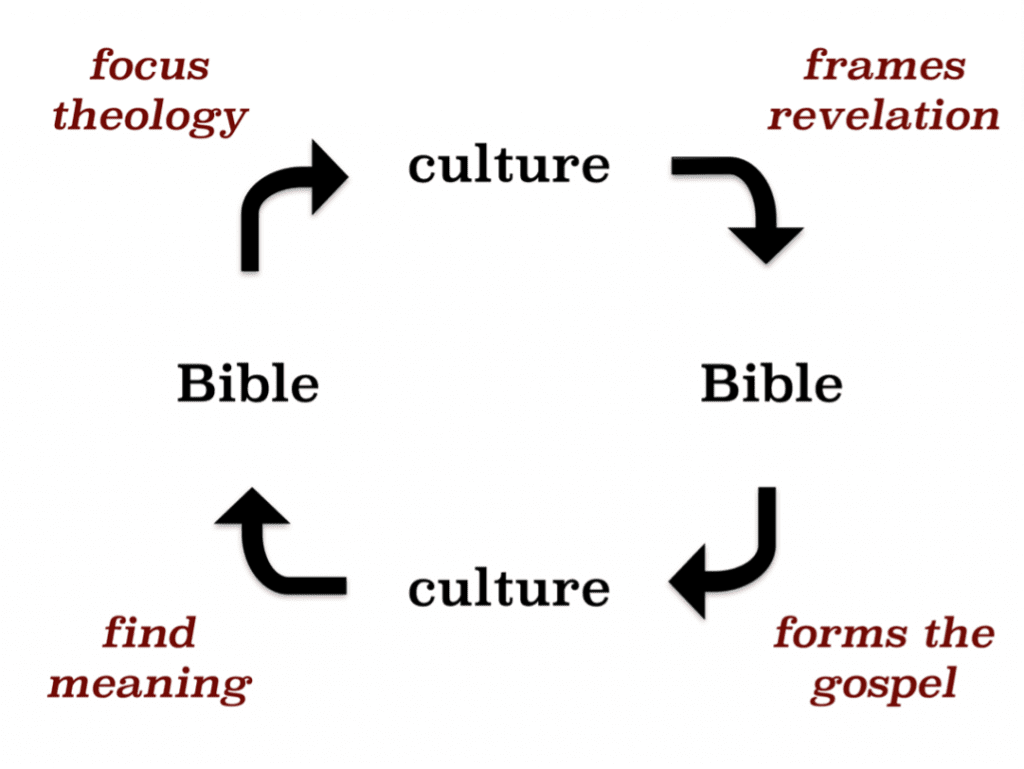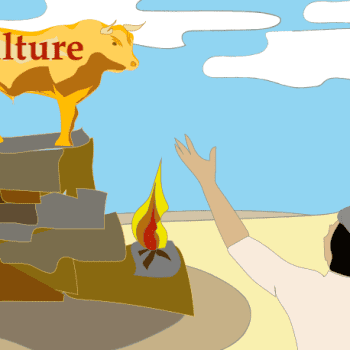This first post in a contextualization mini-series will explain the circular relationship between the Bible and culture. It supplements the content found in One Gospel for All Nations. The next post will build on this foundation, surveying the four primary stages of contextualization.
From Culture to Bible and Back
-
Culture FRAMES God’s revelation
Everything begins with culture. Yes, you read that correctly. Why? God used various ancient cultures to shape the content of his revelation (i.e., the Bible). He uses assorted concepts from said cultures to reveal his character, his will, and his plans. These include Ancient Near Eastern (ANE) covenants and temples as well as the practice of circumcision. The “image of God” concept was borrowed from neighboring ANE cultures (On this last point, check out either a summary explanation or a more robust academic treatment.) Ancient people within the ANE world were very familiar with these symbols and ideas, which is why God used culture to frame his self-revelation.
This is why I and others have said, “All theology is contextualized.” Not only do all people read the Bible through a cultural lens (reason #1), but also contextualization is rooted in the process of biblical revelation itself (reason #2). Although culture logically precedes revelation, it is the Bible that ultimately holds authority. This is no contradiction. In Saving God’s Face, I explain . . .
The argument hinges on an order fallacy. To ask whether the Bible or culture has “priority” is unclear. The idea of “priority” can refer either to temporal sequence (i.e. what comes first) or to authoritative rank (i.e. what has authority). According to the fallacy, it is supposed that whatever comes first temporally has greater authority. To the contrary, sequence is not always supreme. For example, in the apologetics . . . one can easily see how reason initially has epistemological authority (over revelation) in its defense of sola scriptura. (SGF, 60)
In other words, the Bible is decisive, not culture, yet God reveals himself through already existing human cultures. God used cultures to contextualize his self-revelation. The fact that culture is sequentially prior to revelation does not undermine biblical authority.
-
The Bible FORMS the gospel.
The Bible proclaims the gospel, not culture. It inherently limits whatever authority someone might ascribe to culture. Not only this, but the Bible also determines the content of the gospel. Therefore, we cannot casually decide which themes we want to emphasize. No matter our culture or denomination, the entire Bible decides what is important (not just our favorite portions of the Bible). All cultures are called to conform to biblical revelation. The gospel does not change from one culture to another. (The practical significance of this point will become clearer in the second post of this series.)

At this point, a quote from Lesslie Newbigin is fitting:
There can never be a culture-free gospel. Yet the gospel, which is from the beginning to the end embodied in culturally conditioned forms, calls into question all cultures, including the one in which it was originally embodied.
His statement deserves a lifetime of reflection.
-
Culture helps us FIND biblical meaning.
We all have intellectual, cultural, and emotional baggage we bring to the biblical text. Our knowledge (or lack thereof) will affect what we pay attention to. In short, our cultural lens helps us find meaning from within the text. I did not assert that we can use culture to insert meaning into the Bible. Rather, culture invariably acts as our lens to interpret Scripture. Our eyes act as natural filters, either for good or bad. Again, I did not say our culture determines the Bible’s meaning. Rather, our lens determines our field of vision. Accordingly, our cultural lens gives us insight, but it also limits our understanding. For example, if I previously have never seen a dog, then I’ll have difficulty understanding those places where the Bible mentions “dogs.”
-
The Bible FOCUSES our explanations and applications
Having interpreted the Bible (via our cultural lenses) and discerns theological understanding, then what? The Bible focuses our theological explanations and applications. In other words, it both critiques and challenges contemporary culture. The Scriptures lead us in properly communicating truth to the surrounding context. The Bible decides what is honorable or shameful, what is right or wrong. Likewise, the Bible narrows our priorities. From the various cultural themes and issues available to us, biblical text gives us our focus to address what is of utmost importance.
A Few Key Ideas
Many people only want to say the Bible transcends culture. However, the facts present us with a far more complex scenario. The Bible and culture have an organic relationship. In the model depicted above, “culture” is not static. “Culture” initially refers to the ancient biblical contexts that inform the biblical text. “Culture” then includes the varied backgrounds and experiences that inform our view of the world. Finally, “culture” signifies the contexts in which we live and serve. I’ll conclude with a few key takeaways….
- Scripture and culture are intertwined.
- The Bible is rooted in history.
- The gospel is not abstract.
In the coming posts, I’ll build on this discussion to formulate four stages to the contextualization process.














